| Article ID | Journal | Published Year | Pages | File Type |
|---|---|---|---|---|
| 9757476 | Vibrational Spectroscopy | 2005 | 6 Pages |
Abstract
Near infrared spectroscopy (NIRS) is a convenient noninvasive method for measuring both tissue oxygenation and total hemoglobin. The utility of this method was investigated using a porcine model for detecting areas of ischemia and monitoring intestinal hemodynamics. Sections of the small intestine were isolated to study ischemia and reperfusion. The segments were divided into control and two arterial-venous occlusion treatment groups, which were monitored by NIRS. Oxygenation and total hemoglobin showed no significant change over the duration of the protocol in the control segments. Oxygenation of the treatment segments dropped promptly upon, and remained depressed during occlusion. This variable was promptly restored to pre-occlusion levels in the segments that were later reperfused. Total hemoglobin displayed an increase in treatment groups, which can be attributed to insufficient occlusion to the four segments. Spectroscopic measurement of oxygenation and total hemoglobin precisely tracked the hemodynamic manipulations performed on each segment of the jejunum. NIRS provides a rapid and reliable means of detecting and monitoring ischemic regions of the small intestine. The ability to measure tissue oxygenation and to track perfusion using total hemoglobin as an indicator of blood volume make NIRS an attractive tool for noninvasive assessment of regional hemodynamics of the small intestine.
Related Topics
Physical Sciences and Engineering
Chemistry
Analytical Chemistry
Authors
Elicia Kohlenberg, Jeri R. Payette, Michael G. Sowa, Michelle A. Levasseur, Christopher B. Riley, Lorenzo Leonardi,
